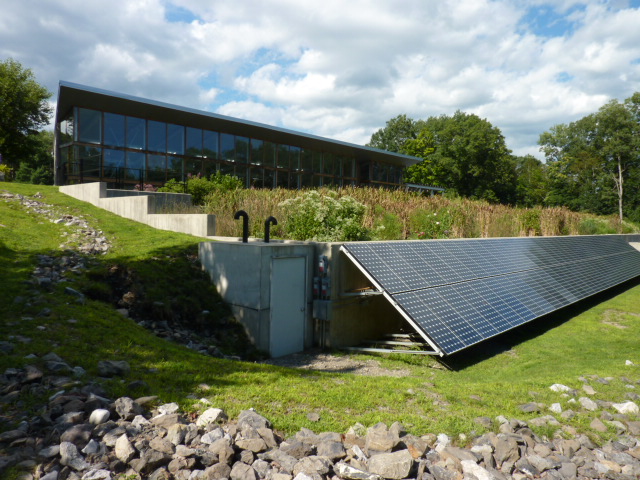The Omega Institute in Rhinebeck, New York—most often associated with yoga and alternative philosophies — decided to apply mindfulness to a very practical matter.
The Omega Center for Sustainable Living (OCSL ) opened in 2009. At the heart of the OCSL is the Eco Machine ™, designed by John Todd Ecological Design. This water reclamation system cleans water by mimicking the processes of the natural world. Using a seven-step process, it cleans water without using any chemicals. Solar power supplies all the energy necessary to the process, and the purified water eventually returns to the aquifer through large dispersal fields located under the campus parking lot.
 The system processes up to 52,000 gallons of water per day when the campus is open—April to October—and about 5,000 gallons per day in the off season. In addition, it functions as an educational tool that teaches and inspires visitors about the power of nature to provide solutions.
The system processes up to 52,000 gallons of water per day when the campus is open—April to October—and about 5,000 gallons per day in the off season. In addition, it functions as an educational tool that teaches and inspires visitors about the power of nature to provide solutions.
“The OCSL is a dynamic, living and breathing demonstration of how interconnected we all are with the world around us,” says Skip Backus, the engaging CEO of Omega, who has had a hands-on role through the entire process. “Our goal is to help people reexamine how they relate to the world by showing them what’s possible in terms of environmental sustainability, green energy, and regenerative design.”
All water from the Omega campus, including that used in toilets, showers and sinks, flows to the Eco Machine(TM) where it is purified by algae, fungi, snails, bacteria, and plants. The first step of the process is the underground solid settlement tanks– where microorganisms in two 5,000 gallon tanks digest ammonia, potassium, phosphorous, nitrogen, and many other substances.
 The water then flows into four constructed wetlands. According to Omega, there is “a 75 % increase in the water’s clarity and a 90 % reduction in the water’s odor” just from having passed through the anoxic tanks and wetlands.
The water then flows into four constructed wetlands. According to Omega, there is “a 75 % increase in the water’s clarity and a 90 % reduction in the water’s odor” just from having passed through the anoxic tanks and wetlands.
Next, it enters the greenhouse and it’s aerated, ten foot-deep lagoons. Luxuriant tropical plants grow above the water, and their roots, in cooperation with fungi, algae, snails, and other microorganisms convert ammonia into nitrates, and toxins into harmless base elements beneath the waterline. Within these soil-less lagoons, the plants live on metal racks, and their roots extend as far as five feet down, providing a habitat for diverse organisms in the lagoon. “The flowers of these tropical plants illustrate the beauty that naturally treated “wastewater” can yield.” says Skip.


